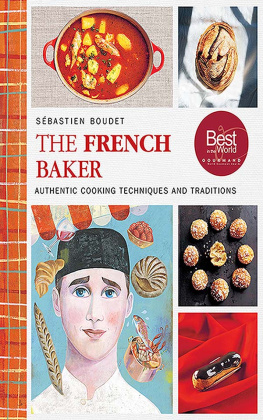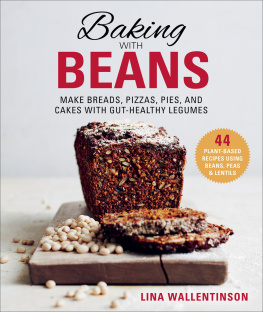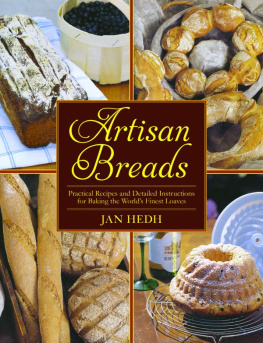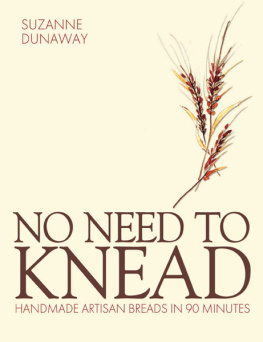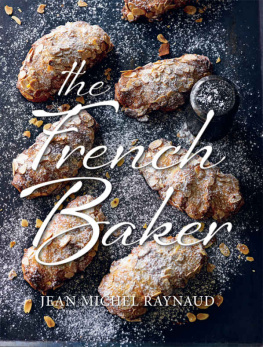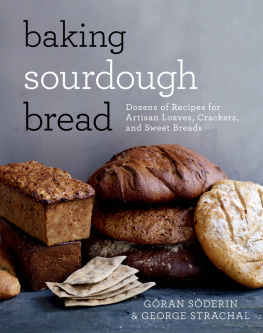THE FRENCH BAKER
SBASTIEN BOUDET
THE FRENCH
BAKER
AUTHENTIC RECIPES FOR TRADITIONAL
BREADS, DESSERTS, AND DINNERS
TRANSLATED BY VERONICA CHOICE
PHOTOGRAPHER CARL KLEINER ILLUSTRATOR OLAF HAJEK ART DIRECTOR JUSTINE LAGACHE

SKYHORSE PUBLISHING


WHY I WOULD
NEVER WRITE
A BOOK
Ive always said that I would never write a cookbook. A recipe is a live being to me, with a soul that continuously changes and evolves. In my own recipe books, I have crossed sections out, written notes and comments, and made corrections all over the place.
Over the years, I have worked, baked, and cooked food in many different countries, and Ive learned the hard way that recipes are not worth much if you dont understand the processes behind them. Proportions can vary depending on how you bake or cook, where you bake or cook, or simply based on what kind of ingredients you use.
My biggest concern about publishing my recipes in a book has been: How will my wonderful recipes live on and continue to grow and evolve if they are written down in a finished book? How can I influence the dish when the book finally ends up in the readers hands? How can I help the cook or baker if things go wrong, if the results are unsuccessful, or if they simply dont work? Thankfully, all my questions were answered when I took up blogging.
A small stone in a sourdough bread loaf and an angry customer turned out to be my reasons for starting my blog; so now, you, my reader, can have a direct link to me via my blog at www.brodpassion.se. Here, you can follow my everyday experiences and get extra materials in the form of pictures, blog commentary, and recorded recipes. Not even I know what my blog will have in the future. But through my blog, I know I will be able to influence my book long after it has been published.
Crafting this book was a journeyboth figuratively and literally. During the fall of 2011, I went with some of the people who have been involved in this project to beautiful Pau in the south of France. Our goal was to cook food, eat, document, write, andmost importantlybe inspired. Now, many miles later, the book is finally finished.
The French Baker is about love for delicious sourdough bread and for the great foods we eat, but most of all, it is about love for humanity. Because in my life, thats where great food begins.




SOURDOUGH
SCHOOL
I have always been fascinated by the fact that so many people bake. But even with all this passion and dedication to the craft, it seems to me as though there is a lack of knowledge about basic ingredients among both professionals and those who bake at home. Today, you can find recipes everywhere, and its easy to forget what matters the most: the soul of the recipe and a genuine understanding of its ingredients. All you really need to make great tasting bread is flour, salt, and water. Once you understand the function of each ingredient, your bread will taste even better, youll be more successful each time you bake, and youll find the process to be much more enjoyable.

YEAST OR
SOURDOUGH?
This has been a hot topic of discussion among professionals and bakers at home, and it has been covered extensively in many blogs, including my own. My preference is to almost always bake with sourdough. Baking with sourdough is about four aspects:
THE PHILOSOPHICAL ASPECT
THE CULINARY ASPECT
THE PRESERVABILITY ASPECT
THE HEALTH ASPECT
THE PHILOSOPHICAL ASPECT
The leavening of the sourdough is what I love the most. It gives me a sense of calm, a certain rhythm, and a feeling of freedom. Every time I mix sourdough, water, flour, and sea salt, millions of microorganisms are activated. Within this chaotic world, microorganisms simply try to do what they are programmed to: live, eat, reproduce, and tear down anything that gets in their way. The laws of nature rule here, and we humans are just the observers. The observer who wants to be an actor? Well, thats me, the sourdough baker.
I consider sourdough baking to be one of the most gratifying tasks there is. When my alarm clock goes off in the morning, my first thought is about my dough. These have been leavening during the night, working on their own, and are now waiting for me to bake with them.
Working with yeast is a totally different experience. Breads made with yeast have elements that have to be timed correctly and executed in a faster speed under more stressful circumstances. I consider this a disadvantage. However, many people try to turn this to their advantage, hoping to fit the baking process into their stressful lives, where the bread has to be finished within a few hours. I want to experience the complete opposite. The time and freedom that baking with sourdough allows me is robbed from me when I bake with yeast.
I have read many sourdough recipes that contain both yeast and sourdough. I dont understand why anyone would want to use yeast, which is made for quick baking, together with sourdough, which is specifically intended for slow baking. I think its important to be consistent. There is a method out there for everyoneno matter which one it isand you should choose your leavening method based on how much time you actually have available.
THE CULINARY ASPECT
The right leavening method depends entirely on which bread you want, for what purpose you intend to use it, and what kind of flavor and appearance you are after. Sourdough leavening takes time and results in deeper flavorsnothing new in that. I have never heard of a wine, a cheese, or vinegar that has exploded with flavor after only thirty-five minutes. During the leavening process, flavors and aromas develop along with texture and porosity, and, of course, there will be a big difference in the end product depending on how long the dough has been leavening and in what manner. Sourdough is heavier and more compact, but also has a creamier crumb consistency; yeast offers a fluffier, lighter, and more airy consistency. The texture, taste, and color of the crumbs depend in large part on how the dough is mixed. You can achieve an airy sourdough bread with the help of a sturdy mixer, but by doing so you will lose some of the flavor. The crumbs of the sourdough bread also stay moist longer than bread that is made with yeast; this allows the crust of the sourdough bread to develop better. Bread that has been baked with yeast has a tendency to dry up quickly if its baked for too long. (If you bake with yeast but want to bake it for a longer period of time to achieve a harder crust, you can always add fat to the doughfor example, olive oil, butter, pig or duck fat.)

